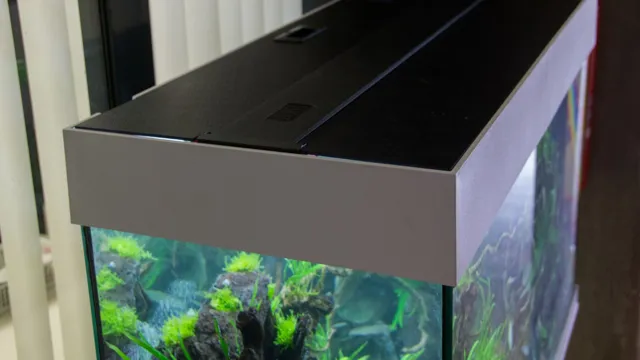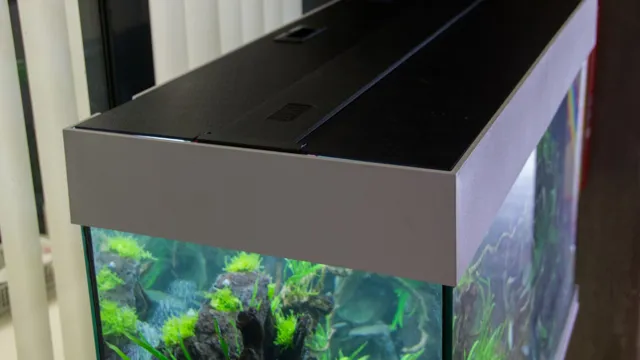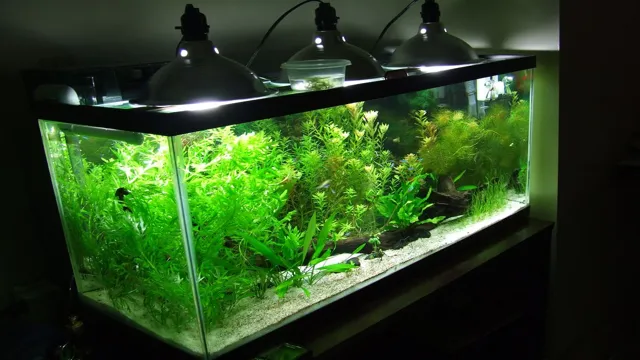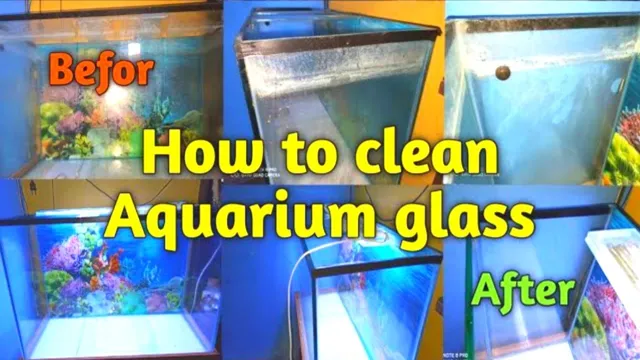As aquarium owners, we always strive to provide the best possible environment for our aquatic pets. But did you know that small openings in your aquarium top can be a potential hazard for your fish? These gaps can allow dust, insects, and even small animals to enter into the tank, causing harm to your pets. In this blog, we’ll explore different ways to cover those small openings in your aquarium top to provide a safer environment for your beloved fish.
We’ll discuss the types of covers available and their benefits, as well as the importance of proper maintenance to ensure your cover stays in tip-top condition. So, let’s dive in and keep our aquatic friends safe and sound!
Introduction
Aquariums are a wonderful addition to any home or office, but they do require a bit of maintenance to keep them looking their best. One common issue that aquarium owners face is how to cover small openings on their aquarium top. These openings are necessary for filtration systems and other equipment, but they can also let unwanted debris and pests into the tank.
Thankfully, there are a few simple solutions that can help you cover these openings and keep your aquarium clean and healthy. One easy option is to use a mesh screen to cover the opening. This will allow air and water to flow freely while keeping out unwanted debris.
Another option is to use a clear plastic sheet to cover the opening, which will provide a more seamless look while still allowing light to enter the tank. Whatever option you choose, be sure to measure the opening carefully to ensure a snug fit and keep your aquarium looking its best!
Why cover small openings on aquarium tops?
If you’re an aquarium owner, you’ve probably heard about the importance of covering the small openings on your tank’s top. Don’t worry if you haven’t yet, because we’re here to explain why it’s a crucial aspect of aquarium maintenance. The main keyword we’ll be focusing on is “aquarium tops”.
Aquarium tops are designed to prevent your fish from jumping out of their tanks and to protect them from external factors. However, most aquarium tops have small openings for filters, heaters, and other accessories to fit through. These openings may seem insignificant, but they can be an entry point for foreign objects, insects, or even other pets in your home.
That’s why it’s important to cover these openings. In addition to protection against foreign objects, covering the small openings on your aquarium top can also help maintain the water quality in your tank. Any gap can break the closed system, creating an unbalanced environment for your fish.
This can result in changes in temperature and water chemistry, leading to stress and illness for your aquatic pets. Not covering those small openings can also impact your aquarium’s humidity levels, potentially causing corrosion or mold growth on equipment, which may require repairs or replacement. Bottom line, covering small openings on aquarium tops is a sound strategy to safeguard the health and wellbeing of your aquatic pets while minimizing the chances of external factors affecting your tank’s environment.

Types of Coverings
If you’re looking for ways on how to cover small openings on your aquarium top, then there are a variety of coverings available to help you out. One popular option is using mesh screens. They’re affordable, easy to install, and come in different sizes to fit your aquarium’s dimensions.
Another choice is using clear acrylic sheets. They offer a sleek and modern aesthetic while still allowing for ample light penetration and oxygen exchange. If you want something more durable, then glass tops may be your best bet.
They provide a seamless and sturdy surface but can be more expensive and heavier. No matter which option you choose, make sure it’s secure and fits snugly to prevent any curious fish from jumping out of the tank. With the right choice of coverings, you can ensure the safety and well-being of your aquatic pets while still enjoying a clear and unobstructed view of their underwater world.
Mesh Screens
Mesh screens are one of the most popular types of coverings available today. They come in various forms and sizes to suit different needs. The two most common types of mesh screens are made of metal and plastic.
Metal mesh screens are more durable and can withstand extreme weather conditions. They are commonly used in industrial settings where the safety of workers is paramount. On the other hand, plastic mesh screens are lighter and more flexible, making them ideal for residential use. (See Also: How to Get White Film off Aquarium Glass: Tips and Tricks to Achieve Crystal Clear Water in 5 Easy Steps)
They are a cost-effective way to keep insects, leaves, and debris out of your home without sacrificing airflow. Mesh screens come in various shapes and sizes, including rectangular, round, and square, to fit any window or door frame. In conclusion, mesh screens are a versatile and stylish way to cover your home’s openings while allowing fresh air to circulate.
Acrylic or Glass Panels
When it comes to covering your artwork or display, there are two types of panel coverings that you can choose from: acrylic or glass. Both have their own advantages and disadvantages. Acrylic panels are more durable and shatter-resistant compared to glass panels.
They are also cheaper and easier to handle, making them a popular choice for museums and galleries. However, acrylic panels are prone to scratches and can fade over time due to exposure to UV light. On the other hand, glass panels offer better clarity and do not scratch as easily as acrylic.
They also do not fade over time. The downside to glass panels is that they are heavier and more fragile, making them more difficult to handle and transport. In the end, the choice between acrylic or glass panels depends on your individual needs and preferences.
If durability and affordability are your top priorities, then acrylic panels are the way to go. But if you want to showcase your artwork with the utmost clarity and elegance, then glass panels are the better option.
DIY Coverings
Are you searching for a way to cover small openings on your aquarium top? DIY coverings can be a great solution for aquarium owners on a budget. One simple method involves using window screen material and a frame made of PVC pipes. To get started, measure the size of the opening and cut the PVC pipes to match the length and width.
Next, use PVC connectors to attach the pipes and create a frame. Finally, cut the window screen material to the size of the frame and attach it securely with zip ties. This covering will allow for proper air circulation while keeping your fish inside and any unwanted debris or pets out.
With a little effort, you can create an affordable covering that fits your aquarium’s specific needs.
Creating mesh screen covers
If you’re looking for a cost-effective solution to protect your garden or outdoor space from insects and debris, creating your own mesh screen covers is a great DIY option. Mesh screen covers are easy to make with some basic materials, and they can be customized to fit your specific needs. You can use them to cover food and beverages during outdoor parties or to keep annoying pests out while enjoying some fresh air.
To create your own mesh screen cover, you’ll need a frame, some mesh screen material, and adhesive tape. First, measure and cut the mesh screen material to fit the frame. Then, attach the material to the frame using adhesive tape, making sure to secure it tightly to prevent any holes or gaps.
Finally, attach any additional features such as handles to make the cover easy to move around. With this simple DIY project, you can enjoy your outdoor space without any unwanted visitors.
Making custom acrylic or glass panels
If you’re looking to give your home or office a unique touch, consider making custom acrylic or glass panels. Not only are these coverings durable and easy to clean, but they can also be customized to fit any size and shape you need. With a little bit of creativity and DIY know-how, you can create beautiful panels that add a touch of elegance to any space.
One popular option is to use stencils or vinyl cutouts to create intricate designs or patterns on the surface of the panel. Another approach is to use a combination of colored and clear acrylic or glass to create a stained glass effect. Whatever your vision, the possibilities are endless with custom acrylic or glass panels. (See Also: How to Make Sure Your Aquarium Has Enough Oxygen: Tips and Tricks)
Overall, this is a great way to add a personal touch to any room while also protecting your surfaces from damage.
Purchased Coverings
Covering small openings on the top of your aquarium is important to prevent any fish from jumping out, while keeping them safe within the tank. If you have a small opening, purchased coverings are a great solution that can easily be found at any pet store. These coverings come in many sizes and styles, so it’s important to measure the size of your tank beforehand to ensure a proper fit.
Whether it’s a mesh or plastic cover, there are benefits to both. Mesh coverings allow for better airflow, making it ideal if you have aquatic plants or need aeration in the tank. On the other hand, plastic covers are easier to clean and maintain and are more aesthetically pleasing.
Whatever you choose, remember to regularly check the coverings and make sure they are securely attached to the tank to avoid any accidents. Overall, purchased coverings are a simple and effective way to keep your fish safe and secure in their aquarium.
Pre-made mesh screen covers
If you’re looking for a quick and easy way to protect your plants from pests and harsh weather conditions, pre-made mesh screen covers are a great option. These coverings are readily available at most garden stores and online retailers, and they come in a variety of sizes and shapes to suit your needs. The mesh screen material provides ample ventilation for your plants while still keeping out unwanted pests like insects and rodents.
Additionally, these covers can help regulate temperature and protect against harsh sunlight, providing your plants with the perfect growing environment. Installing pre-made mesh screen covers is a simple process, and they can be easily removed and stored when not in use. Overall, if you want a hassle-free way to protect your plants, pre-made mesh screen covers are a convenient and cost-effective solution.
Ready-to-fit acrylic or glass panels
When it comes to covering your windows, you have the option of purchasing ready-to-fit acrylic or glass panels. These types of coverings are a popular choice for many homeowners due to their durability and ease of installation. Acrylic panels are lightweight and shatter-resistant, making them a safer option for homes with children or pets.
They also come in a variety of colors and textures to match your decor. Glass panels, on the other hand, are scratch-resistant and offer better visibility. They are also a more eco-friendly option as they can be recycled.
One thing to consider when purchasing ready-to-fit panels is the size of your windows. Most companies offer panels in standard sizes, so if your window is an odd shape or size, you may need to get a custom panel made which can be more expensive. Additionally, both acrylic and glass panels require regular cleaning to maintain their clarity and prevent damage.
Ultimately, the decision between acrylic and glass panels comes down to personal preference and the specific needs of your home. If you have young children or pets or are looking for a more affordable option, acrylic panels may be the way to go. If you prioritize a clearer view and a more eco-friendly option, glass panels may be the better choice.
Regardless of which type of panel you choose, these ready-to-fit coverings offer a convenient solution for protecting your windows while adding style to your home.
Conclusion
In a world where even the tiniest gap can spell disaster for your aquatic pets, covering small openings on your aquarium top is crucial. But fear not, fellow aquarists! With a little creativity and some common household items such as mesh, duct tape, or even cut-out credit cards, you can easily create a DIY solution that is both functional and aesthetically pleasing. So go forth and cover those pesky gaps, and rest easy knowing your fish and other critters are safe and sound in their underwater paradise.
“ (See Also: How to Make a Worm Farm in an Aquarium: A Step-by-Step Guide for Beginners)
Recommendations and maintenance tips
Congratulations on purchasing your new coverings! To ensure the longevity and quality of your investment, it’s essential to follow some recommendations and maintenance tips. Firstly, always refer to the manufacturer’s guidelines for specific cleaning instructions. Each material may require different care.
Secondly, regularly check for any signs of wear and tear, and address them immediately. Waiting could lead to further, more expensive damages down the line. Lastly, if possible, avoid prolonged exposure to direct sunlight or moisture, which can cause fading or damage.
These simple steps can help keep your coverings in top shape for years to come, protecting both your investment and your home’s aesthetics.
FAQs
What is the best material for covering small openings on an aquarium top?
The best material for covering small openings on an aquarium top is a fine mesh screen or nylon material specifically designed for aquarium use.
Can I use regular window screening material to cover small openings on my aquarium top?
No, regular window screening material is not recommended for use on aquarium tops as it can have coatings or treatments that can be harmful to fish and other aquatic animals.
How do I measure the size of the opening on my aquarium top to ensure the mesh screen or nylon material fits correctly?
Use a ruler or tape measure to measure the length and width of the opening on your aquarium top, and add an extra inch or two to each measurement to ensure a proper fit.
What should I do if I have multiple small openings on my aquarium top that need to be covered?
You can either cut one large piece of mesh screen or nylon material to cover all of the openings, or use multiple smaller pieces and secure them in place with aquarium-safe adhesive.
Can I use duct tape or regular adhesive tape to secure the mesh screen or nylon material to my aquarium top?
No, duct tape or regular adhesive tape is not recommended for use in aquariums as it can break down and release harmful chemicals into the water. Instead, use aquarium-safe silicone adhesive or clips specifically designed for aquarium use.
How often should I check the mesh screen or nylon material on my aquarium top for wear and tear?
It is recommended to check the mesh screen or nylon material on your aquarium top at least once a month for any signs of wear and tear, and replace it as necessary.
Can I use a solid cover for my aquarium top instead of a mesh screen or nylon material?
While a solid cover may help reduce evaporation and prevent small animals from jumping out of the tank, it can also reduce air flow and trap heat and moisture, which can be harmful to your aquarium’s aquatic animals and plants. It is recommended to use a mesh screen or nylon material instead.







